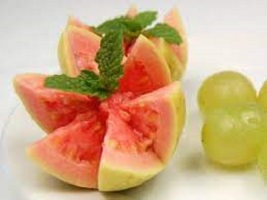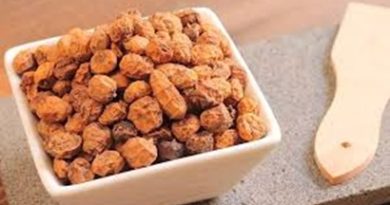Guava Season: When Is Guava in Season? Top Facts
Guava Season: When Is Guava in Season? Top Facts & Tips

Guavas or amrood are sweet and juicy and are all the rage in winters. Guava is one of the trickiest fruits to determine the exact season of fruiting and ripening.
And perhaps you’ve adopted a favorite guava variety and therefore wondering, when is guava season?
You might not think of guavas as a dry-season fruit, but you’d be wrong. This tropical gem has a long, opulent season that begins in November and ends in April.
Guavas are native to Mexico, Central America, and South America, but they’re cultivated all over the world, which is fortunate for us.
Whatever the case may be, we’ll break down the facts concerning guava fruit season in this post.
Related >>>
- Does Swallowing Guava or Tomato Seed Cause Appendicitis
- Guava And Soursop Infusion for Ovarian Cysts – True/False?
- https://9jafoods.com/guava-leaves-for-flat-tummy-and-weight-loss-benefits/
- https://9jafoods.com/easy-guava-leaves-tea-for-weight-loss-belly-fat-burner/
- Guava Leaves for Flat Tummy and Weight Loss – Benefits
- Best Homemade Guava Ice Cream Recipe in Nigeria
- Guava Leaf Tea Uses, Benefits, and Side Effects – How to Brew
Guava Season: Stages of Guava Ripening
When the peel of red or pink guava goes from light green to yellow, it’s time to harvest it.
The fruit is then allowed to ripen further in a room-temperature environment. When full-sized and green to light green, white guava is harvested. When the peel is yellow and the fruit is tender, it is eaten before it is fully ripe.
Is there a season for guavas? guava month season of market demand
Guava trees bloom all year, although the main season is winter. Fruit ripens 90 to 150 days after the first bloom. The color of the fruit changes from green to yellow as it ripens, and becomes much softer.
Is guava a winter fruit?
Guavas are flavorful and fragrant fruits that are green inside and out when raw and turn a pale pink color when ripe.
Guava is a winter fruit that is high in vitamin C, lycopene, antioxidants, and dietary fibers.
Here are some of the health benefits of guava that you can get from eating this amazing fruit:
- Increase your immunity: Guavas are high in a variety of nutrients, particularly vitamin C, which help to improve our immune systems.
- Beneficial to your cardiovascular system
Guavas, like most fruits, assist the body to maintain its salt and potassium balance.
- Facilitates bowel movement
If you suffer from constipation, especially during the winter, you should eat more guavas. Why? Guavas are one of the most nutrient-dense fruits.
- Helps with weight loss
If you eat enough guavas, your body will be in perfect equilibrium, allowing you to have a great metabolism.
- Enhances vision and skin quality
- Stress-relieving and brain-stimulating
Guavas are high in magnesium, which helps to calm the muscles of the body.
Isn’t it true that guava is a fruit of the gods? It is, and you should incorporate them as a seasoning
in your daily winter diet to get all of the health and mental benefits.
Continue reading to learn more about guava season and how to modify it for optimal fruit yield.
The big picture
Guava, or Psidium guajava as it is scientifically known, is an edible fruit that is commonly grown in the tropics.
The Guava plant prefers a warm, humid atmosphere and is susceptible to freezing temperatures.
It’s not that the guava can’t endure freezing temperatures; it’s just that the plant has a hard time growing and producing fruit in extreme cold.
They can also wilt and perish when temperatures drop below 15 degrees Celsius.
Guava may perform well and produce significant numbers of fruit in areas with suitable climatic conditions, such as Zones 8 through 10 in the United States.
The Guava Harvesting Season ~ What is the month/season of market demand for guava?
Guava season is determined by the place where the guava is grown as well as the climatic conditions in which it is grown.
More so, the Guava fruiting period is also affected by fertilizer application and pruning.
Well-pruned guava that has been pruned and fertilized on time can produce more fruits than guava that has not been pruned and fertilized on time.
Healthy guava may produce one to two times each year on average. The harvesting season lasts from November until April.
When is Guava Season in Hawaii?
Guava was supposed to ripen in two different seasons in Hawaii. The two harvest periods are as follows: one begins with crop ripening in August and ends in December, while the other starts in January and ends in April.
In India, when is Guava Season?
According to Indian gardeners, the best time to plant guava is during the rainy season.
Guava may also be grown in India during two different seasons. The first season runs from June to September, while the second runs from February to Match.
Guavas are typically harvested throughout the year in one part of India. In North India, harvesting normally takes place between August and April.
When is Guava Season in Australia?
Guava season in Australia normally lasts from March to May. The Australian guava fruit is enormous, weighing up to 400 grams.
When is Guava Season in Florida?
In Florida, guava is typically harvested all year. The key seasons, however, are August to October and February to March.
In California, when is Guava Season?
Guava cultivars in California are classified as winter varieties. Guavas, on the other hand, can blossom all year in Florida. April is the primary blossoming season.
In South Africa, when is Guava Season?
Guava is often harvested in South Africa between May and October.
When is Guava Season in Nigeria?
The guava harvesting season in Nigeria is usually from June to August.
In Mexico, when is Guava Season?
In Mexico, the guava growing season lasts the entire year.
The most common season is from August to April.
When is Guava Season in Pakistan?
Guava generally flowers twice a year in Pakistan. The first season usually begins in March and ends in April, with the second season beginning in August and ending in September.
The time it takes for flowers to bloom can range from 24 to 45 days. The winter guava is the most popular fruit because it produces more and higher-quality fruit.
What Time of Year do Guavas Ripen?
Guava does not have a certain ripening period. This is since, in warm areas, guava can blossom all year. Guava, on the other hand, blossoms in the spring in the majority of situations.
Guava fruit ripens between 90 and 150 days after blossoming.
This usually happens in the late summer or early autumn. And this is entirely dependent on the location of the guava plant.
How do you know when a Guava is Ready?
When guava is nearly fully ripe, it changes color and aroma. Ripe guavas have a delicate yellowish-green tint. Fully ripe guavas have a fragrant aroma that is similar to a mix of strawberry and pear.
Which is the Best Time to Eat Guava?
On an empty stomach, fruits were found to be well absorbed. This can be done first thing in the morning or as a snack in between meals.
How to Eat Guava, Step by Step
To be honest, you don’t need to know much about how to eat guava – you can just go in and take a bite.
The entire fruit is edible, with a delicious, slightly flowery flavor that tastes like a cross between a strawberry and a pear.
Place the guava on a chopping board and cut it in half if you want to. Then, just like an apple, cut it into wedges.
If you don’t want to eat the rind, cut the guava in half and scoop the flesh from the rind with a spoon, just like an avocado. The flesh can then be sliced if desired.
The flesh of some guavas is pink, whereas the flesh of others is white. They occasionally have harder seeds, which you may find unpleasant even though they are edible.
These can be removed with your fingertips or the knife’s pointed end.
- Incorporate raw guava into dishes
- Cook with guava
Is Guava Better than Apples
Guava is high in phenolic chemicals, which aren’t found in apples. In addition, the vitamin C content of guava is higher than that of apples. Guavas are also less expensive than apples.
Which is better White or Red Guava?
When compared to pink guavas, white guavas have more sugars. Vitamin C, carbohydrates, and seeds are all abundant in white guavas.
Red-fleshed guavas, on the other hand, are high in antioxidants, and carotenoids, and have fewer sugars.
Where do you get guava? Is guava sold in stores? How much does guava cost?
In Nigeria, you can get fresh fruits when in season from the local markets near you at a very affordable price.
Guava juice is frequently available in co-ops and natural foods stores and can be ordered in cartons online (though it’s not cheap).
People also ask
What month is guava season?
Guavas may not seem like a fruit that grows in the winter to you but think again. The long, opulent season for this tropical gem begins in November and lasts until April.
Although guavas are native to Mexico, Central America, and South America, fortunately for us, they are commonly farmed in Florida and on the West Coast.
When is California’s guava season?
Some types, such as the “maroon guava,” have a considerably later season with fruits ripening from December through March.
In California, the majority of guavas flower early in the spring and normally bear fruit in September through November.
When should I buy guava?
Guavas that are fully ripe are slightly soft, and the flesh should yield to gentle pressure like a fully ripe avocado.
Leave rock-hard fruit on the tree to ripen further.
When should guava be avoided?
Eczema: Guava leaf extract should be avoided by those who have eczema as it may make their symptoms worse.
Guava leaf extract contains certain chemicals that might irritate the skin, especially in those with skin diseases like eczema.
When administered topically, guava leaf extract may irritate some people’s skin.
Do guavas grow in the winter?
Guava (Amrood), one of the most eagerly anticipated seasonal fruits, is one of the most popular fruits in Asian nations.
Its origins are in Central America, and in addition to the fruit, the seeds and leaves also provide advantages for the cap.
Do you eat guava skin?
You are welcome to just rinse the guava and start munching on the rind and seeds. Actually, a guava’s rind has more vitamin C than a whole orange.
Place the guava on a chopping board and cut it in half if you want to. After that, cut it into wedges much like you would an apple.
What is the best tasting guava?
Strawberry guava.
Although this tree belongs to a different species, it produces guava fruit, which gets its name from how it tastes.
This fruit is great for eating because it tastes strongly like strawberries.
What guava is the sweetest?
The guava fruit, which originated in Peru approximately 800 BC, has spread to practically every tropical and subtropical region around the world.
The pink guava, however, remains the rarest and sweetest of them all.
Which guava is the best in the entire world?
The Allahabad Safeda and Sardar types dominate the Indian market due to their high yielding potential, excellent quality, and widespread popularity.
The best guava variety in India among the several available types is Allahabad safeda. Both processing and table uses are possible with it.
Is guava fruit a laxative?
Guavas are full of fiber, which can aid with digestion and relieve constipation. What are the disadvantages of guava?
Chemicals in guava leaf extract have the potential to irritate the skin, especially in those who already suffer from skin problems like eczema. Use guava leaf extract with caution if you have eczema.
Guava may help diabetics with blood sugar control. Check your blood sugar before using guava if you have diabetes.
What impact on the body does guava have?
Summary Guava fruit or leaf extract has been shown to lower blood pressure, lower bad cholesterol, and raise good cholesterol, all of which are beneficial for heart health.
Why does guava make you poop?
Fiber is one of the essential elements included in guava.
It has been demonstrated that fiber aids in digestion by both softening and hardening stools.
This can lessen the signs of constipation and diarrhea.
Is guava a kidney stone-causing fruit?
Fact:
Patients with kidney stones do not need to avoid foods like tomato, guava, brinjal, ladies finger, etc. since seeds do not raise the risk of stone formation.
There are several distinct forms of stones, including calcium, urate, oxalate, and others.
Can guava cause blood sugar to rise?
Guava fruit without the peel is more successful at lowering serum LDLc, triglycerides, and total cholesterol as well as blood sugar. Additionally, it raises HDLc levels.
Is it alright to swallow guava seeds?
Yes, eating guava seeds with the whole fruit by lightly biting into them or swallowing them is strongly advised by food experts.
Conclusion
We hope you found this article to be informative. In the comments box below, please share your thoughts and questions.
References: https://www.guavafacts.com/


